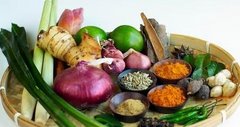
Ingredients:
- 100 g plain flour
- 25 g rice flour
- 1/8 kan sui (lye water)
- 1/2 tsp bicarbonate of soda
- 1/4 tsp salt
- 50g sugar
- 160 ml water
- 100 g chopped roasted peanuts}
- 50g castor sugar } mix together
- 2 tbsp Margarine cut into small pieces
Mix all the ingredients well into a batter and leave aside covered, to rest for at least 30 minutes. Lightly grease a 8-10 inch non-stick frying pan and heat it over a medium low flame. Pour in all the batter and using the base of the scoop/ladle , spread the batter evenly around and to the sides of the pan. Cover pan.
When bubbles are seen on the surface of the half cooked batter, sprinkle a handful of filling over. Spread the pieces of margarine all over the filling. Cover the kuih and cook further for half a minute. Remove the cover and use a flat-bladed knife/spatula to release the sides and bottom of the apam and fold into half. Cool before cutting into wedges.



















